Diamonds Discovered in the Forearc Harzburgites Hint at the Deep Mantle Source of the Skenderbeu Massif, Western Mirdita Ophiolite
Abstract
:1. Introduction
2. Geological Background
3. Analytical Procedures
4. Results
4.1. Whole-Rock Major and Trace Element Composition Analyses
4.2. Mineral Chemistry of the Skenderbeu Harzburgites
4.2.1. Olivine (Ol)
4.2.2. Orthopyroxene (Opx)
4.2.3. Clinopyroxene (Cpx)
4.2.4. Spinel (Spl)
4.3. Diamonds Recovered from the Skenderbeu Harzburgites
5. Discussion
5.1. Formation Processes of the Skenderbeu Harzburgite
5.2. Significance of the Diamond Discovered in the Skenderbeu Harzburgite
6. Conclusions
Supplementary Materials
Author Contributions
Funding
Data Availability Statement
Acknowledgments
Conflicts of Interest
References
- Lago, B.L.; Rabinowicz, M.; Nicolas, A. Podiform chromite ore bodies: A genetic model. J. Petrol. 1982, 23, 103–125. [Google Scholar] [CrossRef]
- Zhou, M.-F.; Robinson, P.T.; Malpas, J.; Li, Z. Podiform chromitites in the Luobusa ophiolite (Southern Tibet): Implications for melt-rock interaction and chromite segregation in the upper mantle. J. Petrol. 1996, 37, 3–21. [Google Scholar] [CrossRef]
- Arai, S. Origin of podiform chromitites. J. Asian Earth Sci. 1997, 15, 303–310. [Google Scholar] [CrossRef]
- Dilek, Y.; Furnes, H. Ophiolite genesis and global tectonics: Geochemical and tectonic fingerprinting of ancient oceanic lithosphere. Geol. Soc. Am. Bull. 2011, 123, 387–411. [Google Scholar] [CrossRef]
- Zindler, A.; Hart, S.R. Chemical Geodynamics. Annu. Rev. Earth Planet. Sci. 1986, 14, 493–571. [Google Scholar] [CrossRef]
- Dobrzhinetskaya, L.F.; O’Bannon, E.F.; Sumino, H. Non-cratonic Diamonds from UHP Metamorphic Terranes, Ophiolites and Volcanic Sources. Rev. Miner. Geochem. 2022, 88, 191–255. [Google Scholar] [CrossRef]
- Yamamoto, S.; Komiya, T.; Hirose, K.; Maruyama, S. Coesite and clinopyroxene exsolution lamellae in chromites: In-situ ultrahigh-pressure evidence from podiform chromitites in the Luobusa ophiolite, southern Tibet. Lithos 2009, 109, 314–322. [Google Scholar] [CrossRef]
- Yang, J.; Meng, F.; Xu, X.; Robinson, P.T.; Dilek, Y.; Makeyev, A.B.; Wirth, R.; Wiedenbeck, M.; Griffin, W.L.; Cliff, J. Diamonds, native elements and metal alloys from chromitites of the Ray-Iz ophiolite of the Polar Urals. Gondwana Res. 2015, 27, 459–485. [Google Scholar] [CrossRef]
- Yang, J.; Wu, W.; Lian, D.; Rui, H. Peridotites, chromitites and diamonds in ophiolites. Nat. Rev. Earth Environ. 2021, 2, 198–212. [Google Scholar] [CrossRef]
- Zhou, M.-F.; Robinson, P.T.; Su, B.-X.; Gao, J.-F.; Li, J.-W.; Yang, J.-S.; Malpas, J. Compositions of chromite, associated minerals, and parental magmas of podiform chromite deposits: The role of slab contamination of asthenospheric melts in suprasubduction zone environments. Gondwana Res. 2014, 26, 262–283. [Google Scholar] [CrossRef]
- Howell, D.; Griffin, W.L.; Yang, J.; Gain, S.; Stern, R.A.; Huang, J.X.; Jacob, D.E.; Xu, X.; Stokes, A.J.; O’Reilly, S.Y. Diamonds in ophiolites: Contamination or a new diamond growth environment? Earth Planet. Sci. Lett. 2015, 430, 284–295. [Google Scholar] [CrossRef]
- McGowan, N.M.; Griffin, W.L.; González-Jiménez, J.M.; Belousova, E.; Afonso, J.C.; Shi, R.; McCammon, C.A.; Pearson, N.J.; OReilly, S.Y. Tibetan chromitites: Excavating the slab graveyard. Geology 2015, 43, 179–182. [Google Scholar] [CrossRef]
- Griffin, W.L.; Afonso, J.C.; Belousova, E.A.; Gain, S.E.; Gong, X.; Gonzalez Jimenez, J.M.; Howell, D.; Huang, J.; McGowan, N.; Pearson, N.J.; et al. Mantle Recycling: Transition Zone Metamorphism of Tibetan Ophiolitic Peridotites and its Tectonic Implications. J. Petrol. 2016, 57, 655–684. [Google Scholar] [CrossRef]
- Harvey, J.; Gannoun, A.; Burton, K.W.; Rogers, N.W.; Alard, O.; Parkinson, I.J. Ancient melt extraction from the oceanic upper mantle revealed by Re–Os isotopes in abyssal peridotites from the Mid-Atlantic ridge. Earth Planet. Sci. Lett. 2006, 244, 606–621. [Google Scholar] [CrossRef]
- Liu, C.-Z.; Snow, J.E.; Hellebrand, E.; Brügmann, G.; von der Handt, A.; Büchl, A.; Hofmann, A.W. Ancient, highly heterogeneous mantle beneath Gakkel ridge, Arctic Ocean. Nature 2008, 452, 311–316. [Google Scholar] [CrossRef] [PubMed]
- Liu, C.-Z.; Dick, H.J.B.; Mitchell, R.N.; Wei, W.; Zhang, Z.-Y.; Hofmann, A.W.; Yang, J.-F.; Li, Y. Archean cratonic mantle recycled at a mid-ocean ridge. Sci. Adv. 2022, 8, eabn6749. [Google Scholar] [CrossRef] [PubMed]
- Bai, W.-J.; Zhou, M.-F.; Robinson, P.T. Possibly diamond-bearing mantle peridotites and podiform chromitites in the Luobusa and Donqiao ophiolites, Tibet. Can. J. Earth Sci. 1993, 30, 1650–1659. [Google Scholar] [CrossRef]
- Dilek, Y.; Shallo, M.; Furnes, H. Rift-drift, seafloor spreading, and subduction tectonics of Albanian ophiolites. Int. Geol. Rev. 2005, 47, 147–176. [Google Scholar] [CrossRef]
- Hoeck, V.; Koller, F.; Meisel, T.; Onuzi, K.; Kneringer, E. The Jurassic South Albanian ophiolites: MOR- vs. SSZ-type ophiolites. Lithos 2002, 65, 143–164. [Google Scholar] [CrossRef]
- Dilek, Y.; Furnes, H.; Shallo, M. Suprasubduction zone ophiolite formation along the periphery of Mesozoic Gondwana. Gondwana Res. 2007, 11, 453–475. [Google Scholar] [CrossRef]
- Dilek, Y.; Furnes, H.; Shallo, M. Geochemistry of the Jurassic Mirdita Ophiolite (Albania) and the MORB to SSZ evolution of a marginal basin oceanic crust. Lithos 2008, 100, 174–209. [Google Scholar] [CrossRef]
- Saccani, E.; Dilek, Y.; Photiades, A. Time-progressive mantle-melt evolution and magma production in a Tethyan marginal sea: A case study of the Albanide-Hellenide ophiolites. Lithosphere 2018, 10, 35–53. [Google Scholar] [CrossRef]
- Dilek, Y. Ophiolite concept and its evolution. Spec. Pap. Geol. Soc. Am. 2003, 373, 1–16. [Google Scholar]
- Wu, W.; Yang, J.; Zheng, J.; Lian, D.; Milushi, I.; Yang, Y.; Qiu, T.; Rui, H.; Guo, G.; Dai, Z.; et al. The earliest stage of mantle-melt evolution during subduction initiation: Evidence from the Neo-Tethyan Mirdita Ophiolite, Albania. Lithos 2022, 434–435, 106937. [Google Scholar] [CrossRef]
- Xiong, F.; Yang, J.; Robinson, P.T.; Dilek, Y.; Milushi, I.; Xu, X.; Zhou, W.; Zhang, Z.; Rong, H. Diamonds Discovered from High–Cr Podiform Chromitites of Bulqiza, Eastern Mirdita Ophiolite, Albania. Acta Geol. Sin. 2017, 91, 455–468. [Google Scholar] [CrossRef]
- Wu, W.; Yang, J.; Wirth, R.; Zheng, J.; Lian, D.; Qiu, T.; Milushi, I. Carbon and nitrogen isotopes and mineral inclusions in diamonds from chromitites of the Mirdita ophiolite (Albania) demonstrate recycling of oceanic crust into the mantle. Am. Mineral. 2019, 104, 485–500. [Google Scholar] [CrossRef]
- Wu, W.W.; Yang, J.S.; Dilek, Y.; Das, S.; Lian, D.Y.; Cai, P.J.; Wang, Y.; Yang, Y.; Wen, Y.Y. Two-pyroxene, intergrowth exsolution textures in ophiolitic chromites: Implications for the deep mantle origin of the Mirdita Ophiolite, Albania. J. Geol. Soc. 2023, jgs2023-128. [Google Scholar] [CrossRef]
- Xu, X.Z.; Yang, J.S.; Chen, S.Y.; Fang, Q.S.; Bai, W.J.; Ba, D.Z. Unusual mantle mineral group from chromitite orebody Cr-11 in Luobusa ophiolite of Yarlung-Zangbo suture zone, Tibet. J. Earth Sci. 2009, 20, 284–302. [Google Scholar] [CrossRef]
- Xiong, F.; Yang, J.; Robinson, P.T.; Dilek, Y.; Milushi, I.; Xu, X.; Chen, Y.; Zhou, W.; Zhang, Z.; Lai, S.; et al. Petrology and geochemistry of high Cr# podiform chromitites of Bulqiza, Eastern Mirdita Ophiolite (EMO), Albania. Ore Geol. Rev. 2015, 70, 188–207. [Google Scholar]
- Ishii, T.; Robinson, P.T.; Maekawa, H.; Fiske, R. Petrological studies of peridotites from diapiric serpentinite seamounts in the Izu-Ogasawara-Mariana forearc, Leg 125. Proceedings of the Ocean Drilling Program. Sci. Results 1992, 125, 445–485. [Google Scholar]
- Parkinson, I.J.; Pearce, J.A. Peridotites from the Izu–Bonin–Mariana Forearc (ODP Leg 125): Evidence for Mantle Melting and Melt–Mantle Interaction in a Supra-Subduction Zone Setting. J. Petrol. 1998, 39, 1577–1618. [Google Scholar] [CrossRef]
- Warren, J.M. Global Variations in Abyssal Peridotite Compositions. Lithos 2016, 248–251, 193–219. [Google Scholar] [CrossRef]
- Okamura, H.; Arai, S.; Kim, Y.U. Petrology of forearc peridotite from the Hahajima Seamount, the Izu-Bonin arc, with special reference to chemical characteristics of chromian spinel. Mineral. Mag. 2006, 70, 15–26. [Google Scholar] [CrossRef]
- Workman, R.K.; Hart, S.R. Major and trace element composition of the depleted MORB mantle (DMM). Earth Planet. Sci. Lett. 2005, 231, 53–72. [Google Scholar] [CrossRef]
- Hellebrand, E.; Snow, J.E.; Hoppe, P.; Hofmann, A.W. Garnet-field Melting and Late-stage Refertilization in ‘Residual’ Abyssal Peridotites from the Central Indian Ridge. J. Petrol. 2002, 43, 2305–2338. [Google Scholar] [CrossRef]
- Kamenetsky, V.S.; Crawford, A.J.; Meffre, S. Factors Controlling Chemistry of Magmatic Spinel: An Empirical Study of Associated Olivine, Cr-spinel and Melt Inclusions from Primitive Rocks. J. Petrol. 2001, 42, 655–671. [Google Scholar] [CrossRef]
- Johnson, K.T.M.; Dick, H.J.B.; Shimizu, N. Melting in the oceanic upper mantle: An ion microprobe study of diopsides in abyssal peridotites. J. Geophys. Res. Solid Earth 1990, 95, 2661–2678. [Google Scholar] [CrossRef]
- Bizimis, M.; Salters, V.J.M.; Bonatti, E. Trace and REE content of clinopyroxenes from supra-subduction zone peridotites. Implications for melting and enrichment processes in island arcs. Chem. Geol. 2000, 165, 67–85. [Google Scholar] [CrossRef]
- Hellebrand, E.; Snow, J.E.; Dick, H.J.B.; Hofmann, A.W. Coupled major and trace elements as indicators of the extent of melting in mid-ocean-ridge peridotites. Nature 2001, 410, 677–681. [Google Scholar] [CrossRef]
- Gong, X.H.; Shi, R.D.; Griffin, W.L.; Huang, Q.S.; Xiong, Q.; Chen, S.S.; Zhang, M.; O’Reilly, S.Y. Recycling of ancient subduction-modified mantle domains in the Purang ophiolite (southwestern Tibet). Lithos 2016, 262, 11–26. [Google Scholar] [CrossRef]
- Liu, T.; Wu, F.-Y.; Liu, C.-Z.; Zhang, C.; Ji, W.-B.; Xu, Y. Reconsideration of Neo-Tethys evolution constrained from the nature of the Dazhuqu ophiolitic mantle, southern Tibet. Contrib. Miner. Petrol. 2019, 174, 23. [Google Scholar] [CrossRef]
- Seyler, M.; Lorand, J.P.; Dick, H.J.B.; Drouin, M. Pervasive melt percolation reactions in ultra-depleted refractory harzburgites at the Mid-Atlantic Ridge 15° 20′N: ODPHole, 1.2.7.4.A. Contrib. Miner. Petrol. 2007, 153, 303. [Google Scholar] [CrossRef]
- Khedr, M.Z.; Arai, S.; Python, M.; Tamura, A. Chemical variations of abyssal peridotites in the central Oman ophiolite: Evidence of oceanic mantle heterogeneity. Gondwana Res. 2014, 25, 1242–1262. [Google Scholar] [CrossRef]
- Ballhaus, C.; Berry, R.F.; Green, D.H. High-pressure experimental calibration of the olivine-orthopyroxene-spinel oxygen geobarometer: Implications for the oxidation state of the upper mantle. Contrib. Miner. Petrol. 1991, 107, 27–40. [Google Scholar] [CrossRef]
- Parkinson, I.J.; Arculus, R.J. The redox state of subduction zones: Insights from arc-peridotites. Chem. Geol. 1999, 160, 409–423. [Google Scholar] [CrossRef]
- Dare, S.A.S.; Pearce, J.A.; McDonald, I.; Styles, M.T. Tectonic discrimination of peridotites using fO 2–Cr# and Ga–Ti–Fe III systematics in chrome–spinel. Chem. Geol. 2009, 261, 199–216. [Google Scholar]
- Shervais, J.W. Birth, death, and resurrection: The life cycle of suprasubduction zone ophiolites. Geochem. Geophys. Geosyst. 2001, 2, 2000GC000080. [Google Scholar] [CrossRef]
- Pan, Q.-Q.; Xiao, Y.; Su, B.-X.; Liu, X.; Robinson, P.T.; Cui, M.-M.; Wang, J.; Uysal, I. Fingerprinting stealth metasomatism in ophiolitic peridotites. Lithos 2022, 424–425, 106755. [Google Scholar] [CrossRef]
- Arai, S.; Yurimoto, H. Podiform chromitites of the Tari-Misaka ultramafic complex, southwestern Japan, as mantle-melt interaction products. Econ. Geol. 1994, 89, 1279–1288. [Google Scholar] [CrossRef]
- Zhou, M.-F.; Robinson, P.T.; Bai, W.J. Formation of podiform chromitites by melt/rock interaction in the upper mantle. Miner. Depos. 1994, 29, 98–101. [Google Scholar] [CrossRef]
- Arai, S. Conversion of low-pressure chromitites to ultrahigh-pressure chromitites by deep recycling: A good inference. Earth Planet. Sci. Lett. 2013, 379, 81–87. [Google Scholar] [CrossRef]
- Farré-de-Pablo, J.; Proenza, J.A.; González-Jiménez, J.M.; Garcia-Casco, A.; Colás, V.; Roqué-Rossell, J.; Camprubí, A.; Sánchez-Navas, A. A shallow origin for diamonds in ophiolitic chromitites. Geology 2018, 47, 75–78. [Google Scholar] [CrossRef]
- Ballhaus, C.; Wirth, R.; Fonseca, R.O.C.; Blanchard, H.; Pröll, W.; Bragagni, A.; Nagel, T.; Schreiber, A.; Dittrich, S.; Thome, V. Ultra-high pressure and ultra-reduced minerals in ophiolites may form by lightning strikes. Geochem. Perspect. Lett. 2017, 5, 42–46. [Google Scholar] [CrossRef]
- Litasov, K.D.; Kagi, H.; Bekker, T.B.; Hirata, T.; Makino, Y. Cuboctahedral type Ib diamonds in ophiolitic chromitites and peridotites: The evidence for anthropogenic contamination. High Press. Res. 2019, 39, 480–488. [Google Scholar] [CrossRef]
- Das, S.; Basu, A.R.; Mukherjee, B.K. In situ peridotitic diamond in Indus ophiolite sourced from hydrocarbon fluids in the mantle transition zone. Geology 2017, 45, 755–758. [Google Scholar] [CrossRef]
- Moe, K.S.; Yang, J.S.; Johnson, P.; Xu, X.; Wang, W. Spectroscopic analysis of microdiamonds in ophiolitic chromitite and peridotite. Lithosphere 2018, 10, 133–141. [Google Scholar] [CrossRef]
- Gong, X.H.; Shi, R.D.; Xu, J.F.; Huang, Q.S.; Huang, X.X.; Su, B.X. “Garnet” Lherzolites in the Purang Ophiolite, Tibet: Evidence for Exhumation of Deep Oceanic Lithospheric Mantle. Geophys. Res. Lett. 2020, 47. [Google Scholar] [CrossRef]
- Yang, Y.; Yang, J.; Wu, W.; Cai, P.; Ma, H. Microstructural Insights into the Evolution of Ophiolitic Chromite from Luobusha. Minerals 2023, 13, 1047. [Google Scholar] [CrossRef]
- Chen, T.; Jin, Z.; Zhang, J.; Wang, L. Calcium amphibole exsolution lamellae in chromite from the Semail ophiolite: Evidence for a high-pressure origin. Lithos 2019, 334–335, 273–280. [Google Scholar] [CrossRef]
- Ren, J.; Yao, H.; Yang, Y.; Wang, L.; He, G.; Lai, P.; Zhou, J.; Deng, X.; Liu, S.; Deng, X.; et al. Critical metal enrichment in atypical hydrogenetic ferromanganese nodules: A case study in the Central Basin Ridge of the West Philippine Basin. Chem. Geol. 2023, 615, 121224. [Google Scholar] [CrossRef]
- Frost, D.J.; McCammon, C.A. The Redox State of Earth’s Mantle. Annu. Rev. Earth Planet. Sci. 2008, 36, 389–420. [Google Scholar] [CrossRef]
- Rohrbach, A.; Ballhaus, C.; Golla Schindler, U.; Ulmer, P.; Kamenetsky, V.S.; Kuzmin, D.V. Metal saturation in the upper mantle. Nature. 2007, 449, 456–458. [Google Scholar] [CrossRef]
- Rohrbach, A.; Ballhaus, C.; Ulmer, P.; Gollaschindler, U.; Schönbohm, D. Experimental Evidence for a Reduced Metal-saturated Upper Mantle. J. Petrol. 2011, 52, 717–731. [Google Scholar] [CrossRef]
- Rohrbach, A.; Schmidt, M.W. Redox freezing and melting in the Earth’s deep mantle resulting from carbon-iron redox coupling. Nature 2011, 472, 209–212. [Google Scholar] [CrossRef]
- Smith, E.M.; Shirey, S.B.; Nestola, F.; Bullock, E.S.; Wang, J.; Richardson, S.H.; Wang, W. Large gem diamonds from metallic liquid in Earth’s deep mantle. Science 2016, 354, 1403–1405. [Google Scholar] [CrossRef]
- Sokol, A.G.; Palyanova, G.A.; Palyanov, Y.N.; Tomilenko, A.A.; Melenevsky, V.N. Fluid regime and diamond formation in the reduced mantle: Experimental constraints. Geochim. Cosmochim. Acta 2009, 73, 5820–5834. [Google Scholar] [CrossRef]
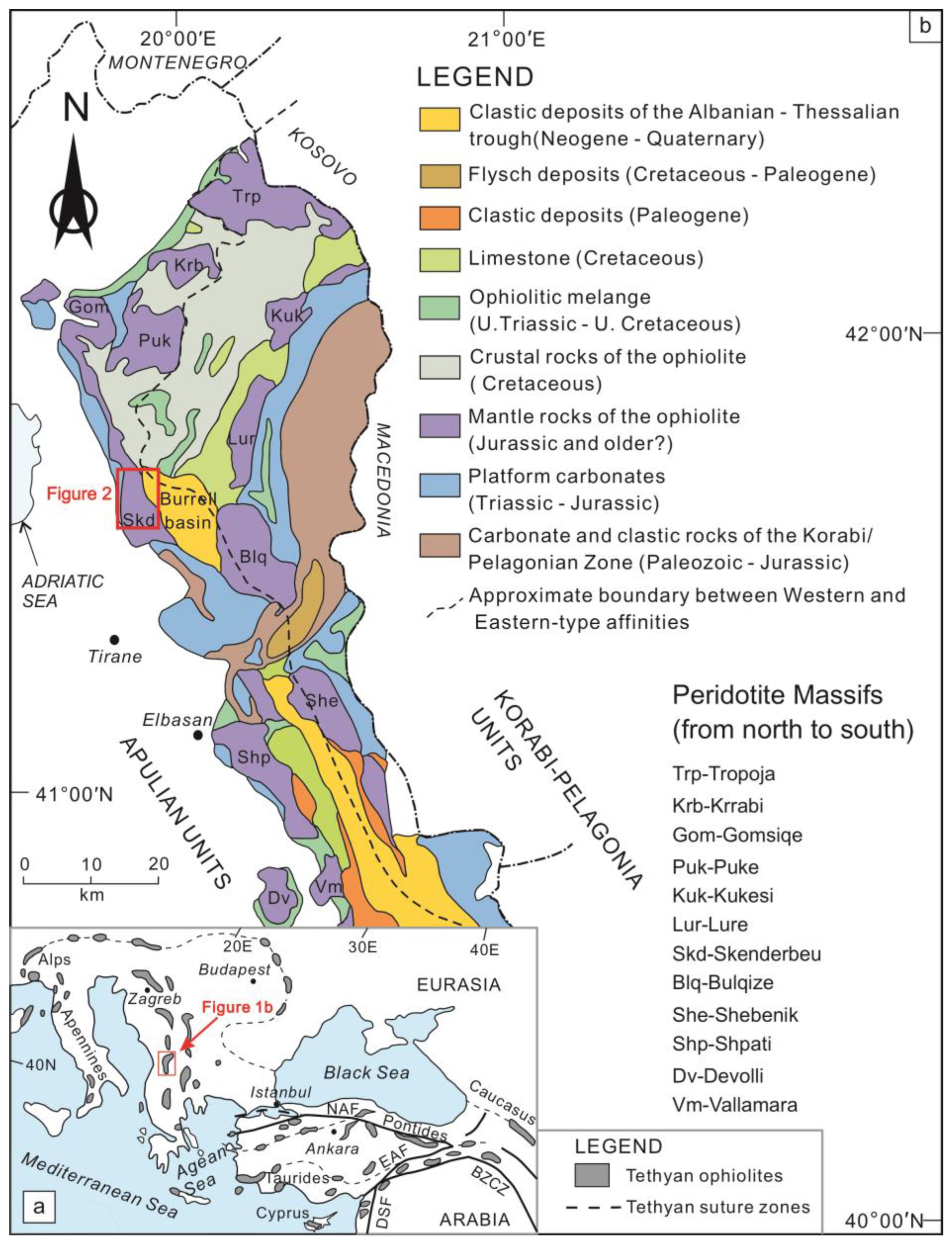



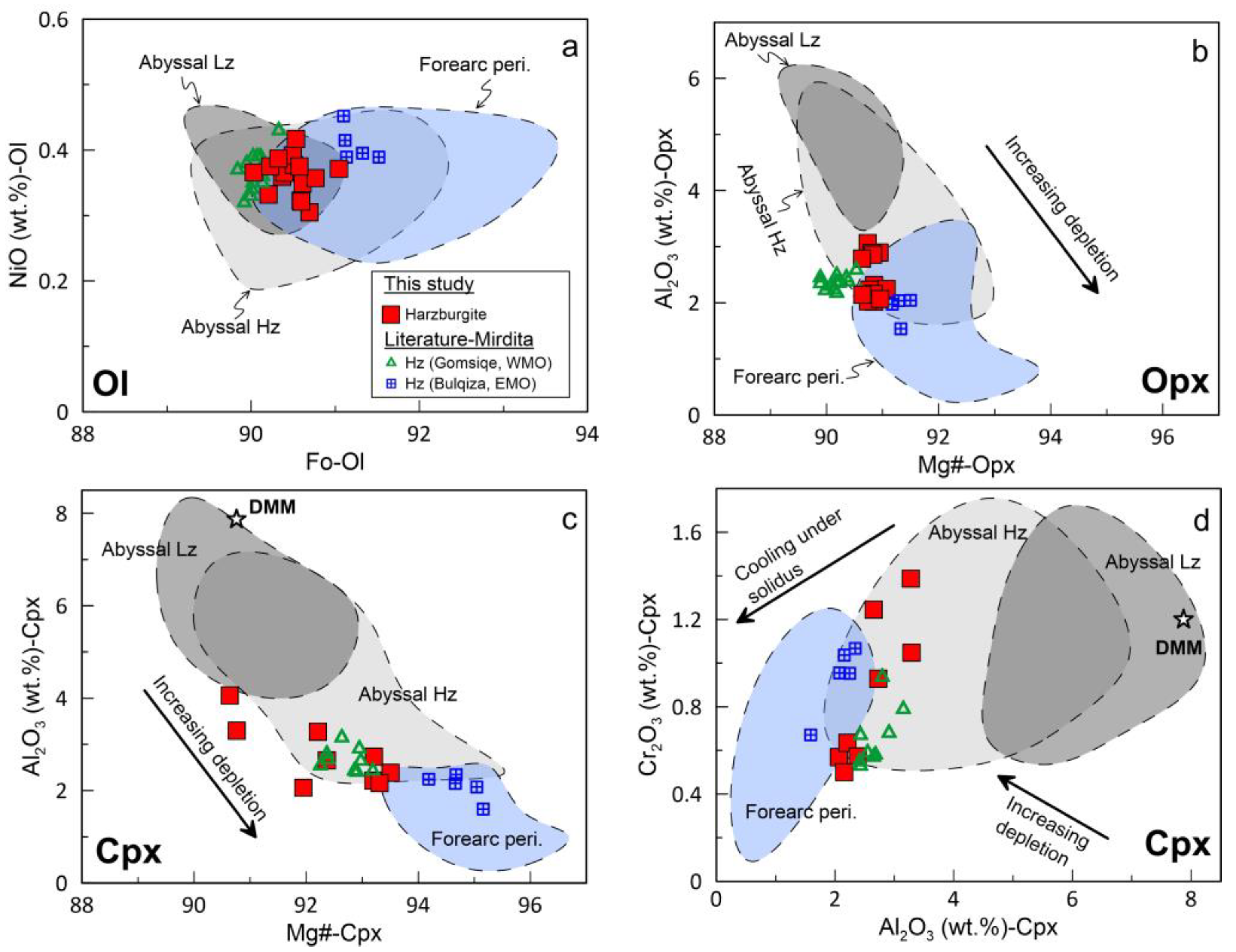

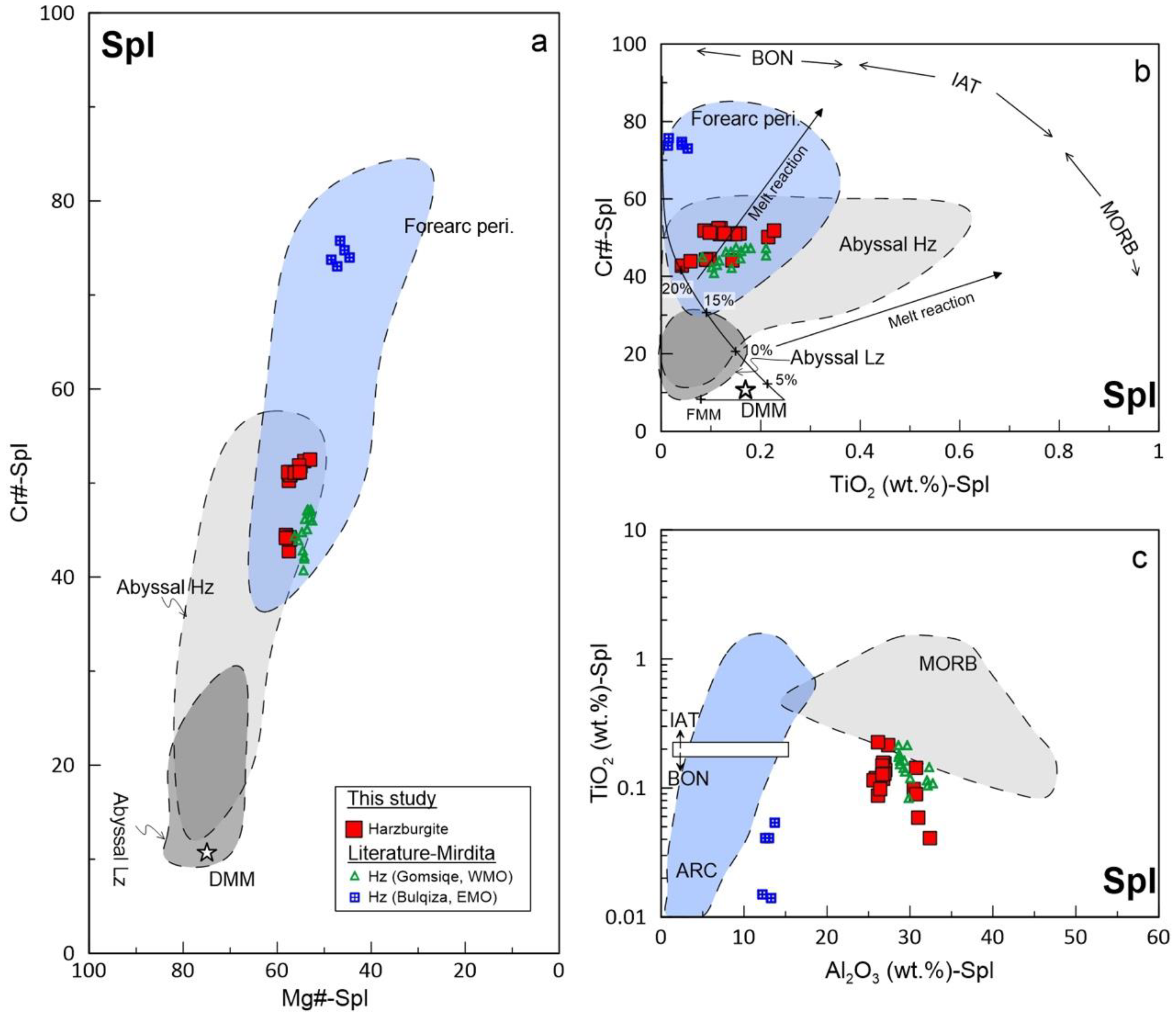
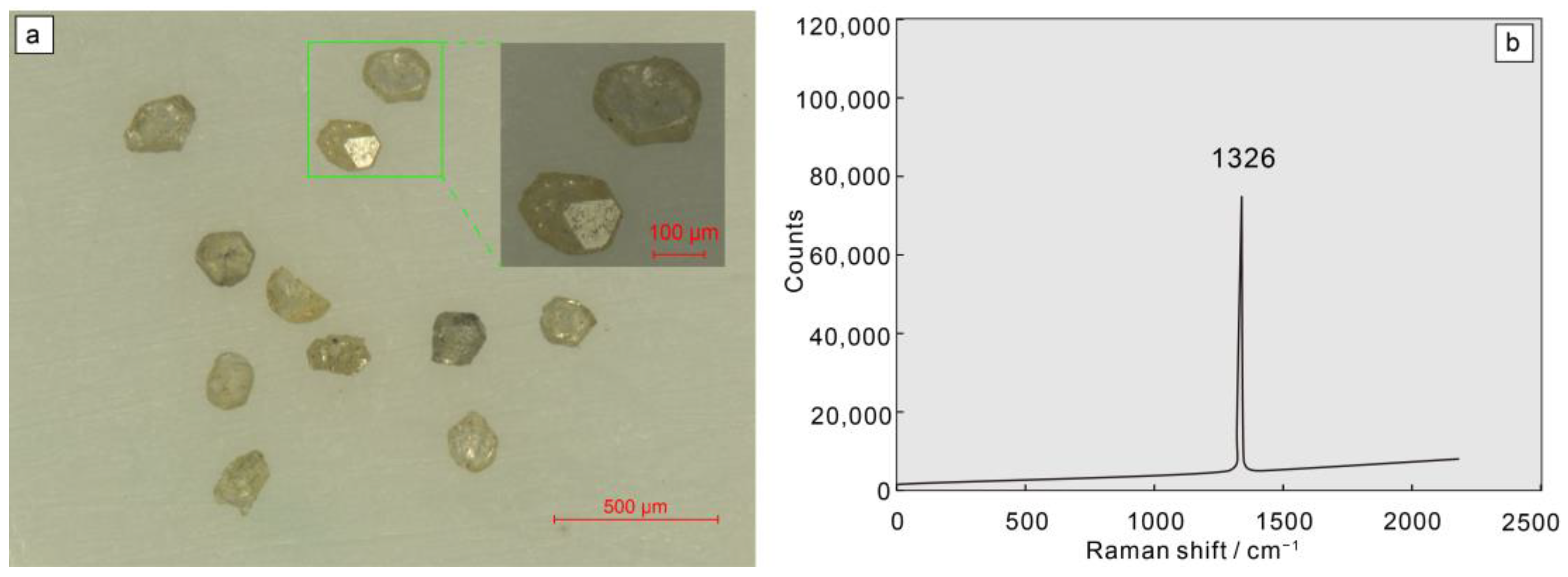
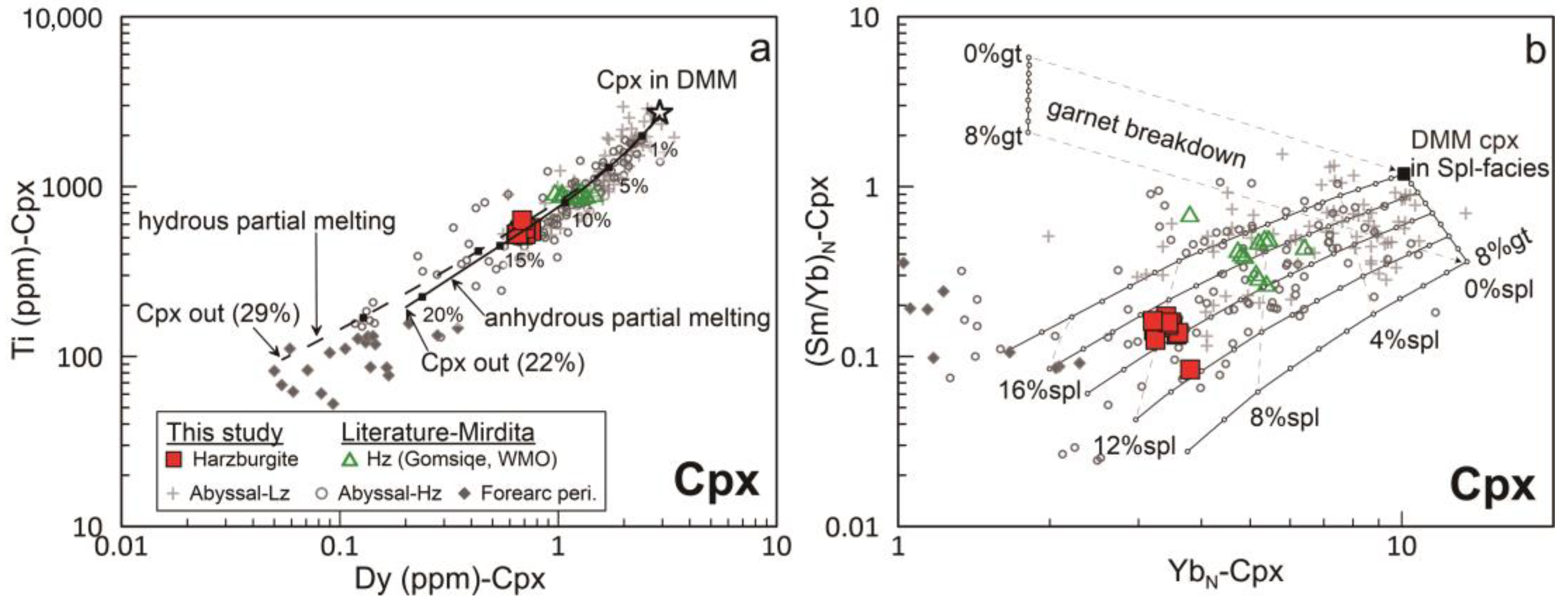
Disclaimer/Publisher’s Note: The statements, opinions and data contained in all publications are solely those of the individual author(s) and contributor(s) and not of MDPI and/or the editor(s). MDPI and/or the editor(s) disclaim responsibility for any injury to people or property resulting from any ideas, methods, instructions or products referred to in the content. |
© 2023 by the authors. Licensee MDPI, Basel, Switzerland. This article is an open access article distributed under the terms and conditions of the Creative Commons Attribution (CC BY) license (https://creativecommons.org/licenses/by/4.0/).
Share and Cite
Wu, W.; Yang, J.; Yang, Y.; Milushi, I.; Wang, Y. Diamonds Discovered in the Forearc Harzburgites Hint at the Deep Mantle Source of the Skenderbeu Massif, Western Mirdita Ophiolite. Minerals 2024, 14, 34. https://doi.org/10.3390/min14010034
Wu W, Yang J, Yang Y, Milushi I, Wang Y. Diamonds Discovered in the Forearc Harzburgites Hint at the Deep Mantle Source of the Skenderbeu Massif, Western Mirdita Ophiolite. Minerals. 2024; 14(1):34. https://doi.org/10.3390/min14010034
Chicago/Turabian StyleWu, Weiwei, Jingsui Yang, Yu Yang, Ibrahim Milushi, and Yun Wang. 2024. "Diamonds Discovered in the Forearc Harzburgites Hint at the Deep Mantle Source of the Skenderbeu Massif, Western Mirdita Ophiolite" Minerals 14, no. 1: 34. https://doi.org/10.3390/min14010034





